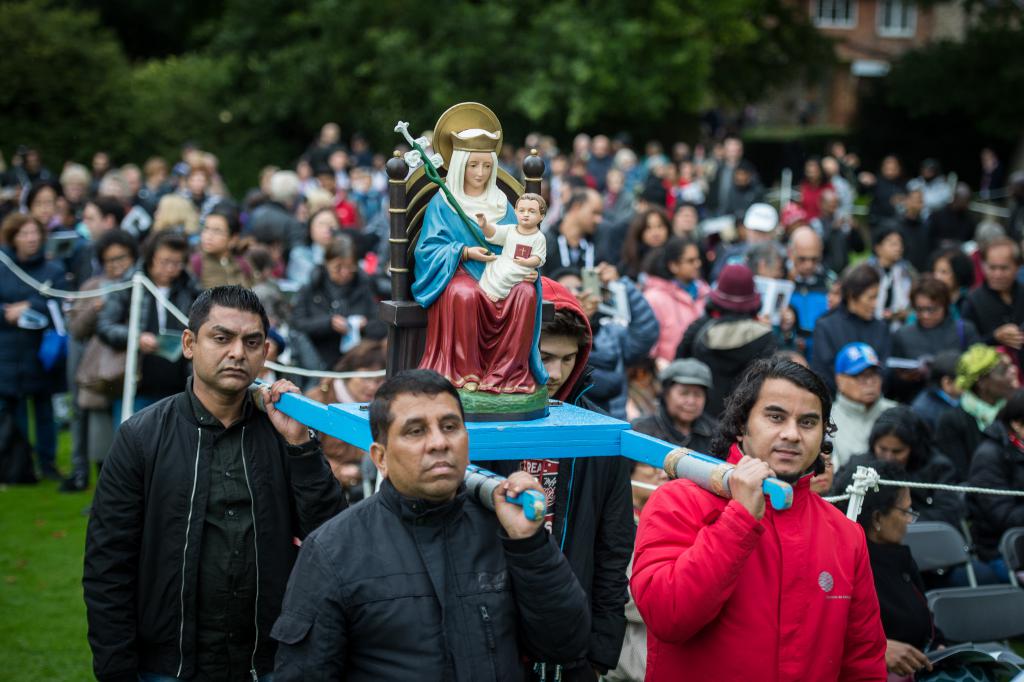by Mgr Mark Langham
As we prepare for our diocesan pilgrimage to Walsingham in September, it is good to recall the significance of Our Lady’s shrine in pre-Reformation times. Last May, at an Anglican celebration in honour of Our Lady of Walsingham, the statue of Our Lady of Walsingham was processed into Westminster Abbey and, in a striking gesture, placed on the spot of the coronation chair. The Anglican Bishop of Burnley, began his powerful sermon with the words: ‘What have we just done? Into this great Abbey church - the Shrine of St Edward the Confessor, the burial site of kings, the place of coronations and regal power - we have just carried a penniless peasant girl from Nazareth.’
At the symbolic centre of the nation’s political life, was enthroned not a mighty king enrobed in gold, but the Mother of God. The Bishop’s point was that the role of Our Lady in the medieval world was not incidental, a pious ornament in a religious life crowded with saints and ceremonies. Rather, Mary was central to the life of the nation, and that, in bringing her image into the symbolic centre of our national life, we recognise her challenge to us to be a nation that, like her, centred on Christ; a nation that is holy and that is dedicated to justice.
On that same occasion, Archbishop Rino Fisichella, President of the Pontifical Council for the Promotion of the New Evangelisation, spoke forcefully of Our Lady as one who ‘pierces the barriers we have constructed to defend ourselves’. No mere bystander, but one who acts to bring us into a correct relationship to the Gospel.
Thus, one of the elements we proclaim in visiting Walsingham is of Mary as protagonist, active in the cause of uniting us with her Son that we may live justly and healthily. This is paradox of the shrine throughout its history: Walsingham is dedicated to one who was in many ways a victim and who knew certainly poverty and political oppression; yet to her have come in pilgrimage kings and princes, kneeling before her in homage.
Even a partial list shows the enormous importance attached to the shrine; among kingly pilgrims were Henry III (1241), Edward I (1280 and 1296), Edward II (1315) and Edward III (1361) who in 1364 gave safe conduct to King David of Scotland and 20 knights to make a pilgrimage to Walsingham. This was more than simple piety, certainly more than superstition. These monarchs recognised our Lady as essential and central to the nation, and to its holiness, which was also its health.
Beyond mere devotion, this was a statement that at the heart of this nation, and grounding its values, was Mary directing us to her Son, exhorting us to keep a sense of direction, of wholeness, of a community founded in Christ. These monarchs saw Mary as one who would contribute health and success to their reign, by recalling to them the Gospel values of her Son who would enable them to govern in justice, charity and wisdom.
It was not just monarchs who sought from Walsingham the active help of Our Lady to be whole and healthy. The famed scholar Erasmus, resident at Cambridge, visited the shrine in 1511 and wrote a poem lamenting that he could not bring gold and jewels as a gift, but was instead ‘bringing his verses only, all he has.’ It was an act of piety, for sure, but for the normally cynical Erasmus something more: a recognition that Our Lady orients him in the right direction, enables him to realise his fullness, his potential, as a scholar. In her own selflessness, Mary grants Erasmus the ability to turn away from self-absorption, to flourish through that generosity of spirit and sense of wonder of heart that are essential to any scholar.
Walsingham, then, is a place that challenges us all to put Mary at the centre of our lives, personally and as a community, in order that we may be whole and healthy. She reminds us that we cannot determine our destiny without reference to Christ. She challenges us to form a society that is vital, caring, creative by holding the Christ-child in our heart. In this light, what better preparation could there be for the 2020 re-dedication of England as Dowry of Mary, than to affirm her active role in promoting our health and wholeness as a society, at Walsingham?


